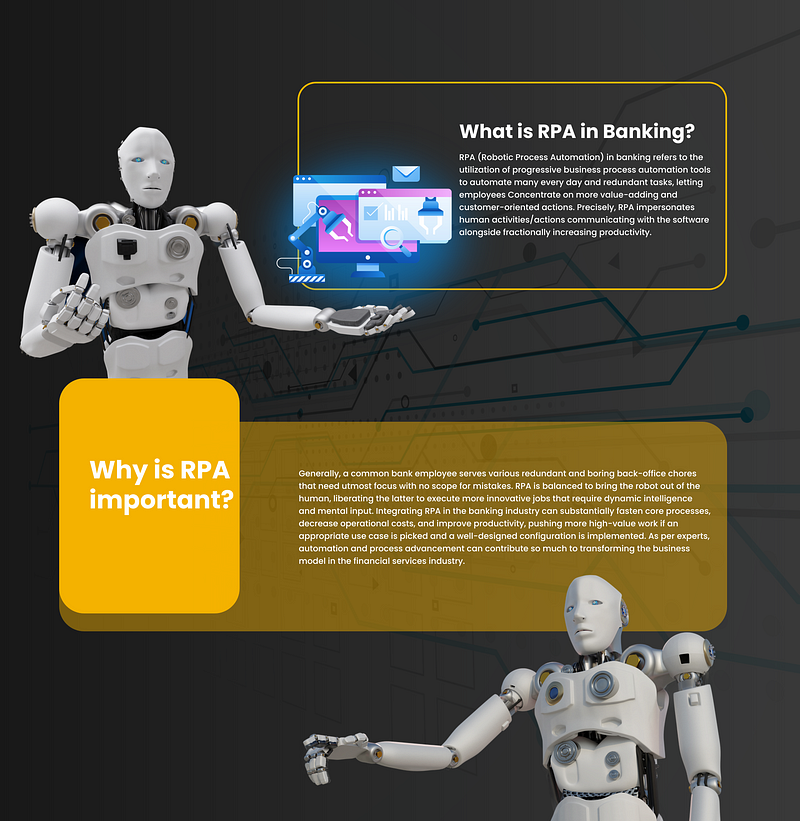No matter what industry you are in, today’s consumers expect things to happen faster than anything. With the fractional rate of technological improvements driving the speed of service, this trend will barely diminish. Specifically in the banking industry, customers anticipate their mortgage loan to be approved the next day and queries answered immediately. Newly launched banks manage to handle these requirements from the origination.
Well, these latest industry partakers with the impact of digital transformation have become real competitors to conventional banking institutions with traditional banking ecosystems. These banks now vigorously turn to robotic process automation deliberating to remain inundated. In this blog, we will understand the most powerful use cases for robotic process automation in finance, highlight real-time RPA applications in banking, describe the implementation perspective, and offer a future perspective for the technology.

Benefits of RPA in Banking

Boosts Employee Efficiency
RPA bots increase the load of redundant and boring chores from humans making employees to focus on better value-adding activities.

Measures Operations
Irrespective of the requests to process and tasks to finish, RPA bots’ performance and precision remain the same, letting banks measure processes on demand.

Reduces Human Mistakes
RPA bots never get exhausted and execute tasks with the identical precision irrespective of task complexity, which decreases the chance of errors.

Less Expenses
By decreasing human involvement in multiple processes, RPA execution allows banks reduce operational expenses by 30% on average.

Promotes Compliance Reporting
Practically, recorded RPA bots’ movements are an audit track, which specifically eases compliance reporting.

Conserves Time
With RPA bots banks can accomplish tasks much faster than humans, allowing banks to meet day-to-day tasks in less time.
5 Top Use-Cases of RPA in Banking

Loan Processing
The number of employees dedicated to processing loans essentially determines the loan processing volume. A part from customer service automation, RPA technology in banking can carry real significance by automating multiple loan administration processes, including underwriting and verification. RPA software enables the autonomous consolidation of appropriate information from paper-based documents, third-party systems, and service providers. Also, RPA tools can feed this data into the right systems for underwriters’ additional analysis.

Customer Analysis
As KYC regulations become increasingly stringent and compliance costs rise, banks are turning to automation to meet regulatory requirements. It is often unjustifiable for banks to automate KYC since revamping an established web of interconnected, yet disparate systems are expensive. RPA systems request that they can be smoothly integrated into existing systems and create less disturbance to the ongoing workflows. RPA automates processes such as setting up which abide by rules, validating, collecting, and assembling customer data.

Accounts Payable
Multiple invoices are still created as paper documents, and there is very less document uniformity. So, accounts payable stays a notable tiresome process that needs a lot of thoughtless copy-pasting. Getting vendor data, reviewing for errors, and starting the payment — are all rule-oriented approaches that organizations can pull off without human engagement. RPA software boosted with optical character recognition (OCR), can easily grab and re-enter data while providing an audit trail in parallel. It also extremely streamlines compliance reporting.

Credit Card Processing
Besides the general digital transformation of banking services that has boosted the issuance of credit cards, the need for human involvement. Majorly, an RPA bot can authorize credit card applications by itself, essentially speeding the process and improving customer satisfaction. An RPA bot can access diverse systems to confirm applicants’ identities, run background verifications, approve, disapprove, or, in irregular cases, divert customers to a human employee.

Fraud Identification
Banks maintain huge amounts of customer data that are favorably susceptible and insecure to cyberattacks. There are multiple machine learning-focused abnormality detection systems, and RPA-enabled fraud detection systems have been confirmed to be practical. Rather than depending on human review and mostly manual data management, banks can implement RPA tools to constantly scrutinize customer transactions, detect peculiarities founded on a vast rule-based system, mark them as potentially harmful, and send warnings to human employees for further consideration. Instead of spending valuable time collecting data, employees can implement their mental abilities where they are required.
Challenges of Implementing RPA in Banking
Integrating of Robotics Process Automation (RPA) for digital transformation is the current trend for conventional banks to stand out in the market with online banking services. RPA offers services as a powerful tool for banks to overpower challenges. But it also has another side of challenges. Are banks geared up for RPA challenges? here are 3 crucial challenges.
Asymmetrical Processes
It is key for banks to keenly evaluate every banking process and its comprehensive effect before identifying possible ones for automation. To assure accurate alignment of the advanced technology with the current framework, handlers should have a clear idea of how roles and responsibilities are assigned across the business’s dimensions. Excluding that understanding, it will turn quite impossible to prioritise processes that needs immediate attention from automation.
IT Support
While employees are hesitant to change because of the mindset, IT departments usually have too much burden on them to support RPA implementation. During this current period of digital transformation, bank IT departments are buckled up to spending significant resources to leap over challenges linked with cloud migration, legacy system supervision, and executing new ERPs. Besides RPA is comparatively less resource-demanding than other automation solutions, the IT team’s acquisition remains important. Therefore, banks require C-executives to get assistance from IT personnel at the earliest. In most cases, gathering a team of existing IT employees that will be committed solely to the RPA implementation is vital.
Resistance To Change
No matter what advantages and offerings a cutting-edge technology can put across, opposition to transformation stays as common obstacles that companies encounter. Employees get habituated to their routine approach towards daily tasks and frequently have a tough time realizing that a new approach is more useful. Hence, change management is important to smooth RPA adoption. As soon as it proves to be clear that RPA implementation is the appropriate initiative to take from a business perspective, banks need to develop exhaustive change management programs to assist employees redirect their mindsets and make the transition as seamless as possible.
FAQs About RPA in Banking Industry
1. What are the primary benefits of RPA in the banking industry?
Robotic Process Automation (RPA) offers numerous benefits to the banking industry, including boosting employee efficiency, reducing human errors, lowering operational costs, promoting compliance reporting, and conserving time. RPA bots take over repetitive tasks, allowing employees to focus on higher-value activities and ensuring tasks are completed with consistent precision.
2. How can RPA improve loan processing in banks?
RPA can significantly streamline loan processing by automating various administrative tasks such as underwriting and verification. RPA software can autonomously consolidate information from paper-based documents, third-party systems, and service providers, feeding the data into appropriate systems for underwriters’ analysis. This speeds up the loan approval process and improves overall customer satisfaction.
3. What role does RPA play in customer analysis and KYC compliance?
RPA enhances customer analysis and KYC (Know Your Customer) compliance by automating processes like setting up customer profiles, validating, collecting, and assembling customer data. RPA systems can integrate seamlessly into existing workflows, reducing the cost and disruption associated with compliance and ensuring banks meet regulatory requirements efficiently.
4. How does RPA aid in fraud detection in banking?
RPA aids in fraud detection by continuously monitoring customer transactions and identifying anomalies based on rule-based systems. RPA bots can flag suspicious activities, sending alerts to human employees for further investigation. This reduces the time spent on manual data reviews and enhances the bank’s ability to detect and prevent fraudulent activities.
5. What challenges do banks face when implementing RPA?
Banks face several challenges when implementing RPA, including dealing with asymmetrical processes, securing adequate IT support, and overcoming resistance to change. Successful RPA adoption requires a clear understanding of current processes, committed IT resources to support the implementation, and comprehensive change management programs to help employees transition to new workflows smoothly.







